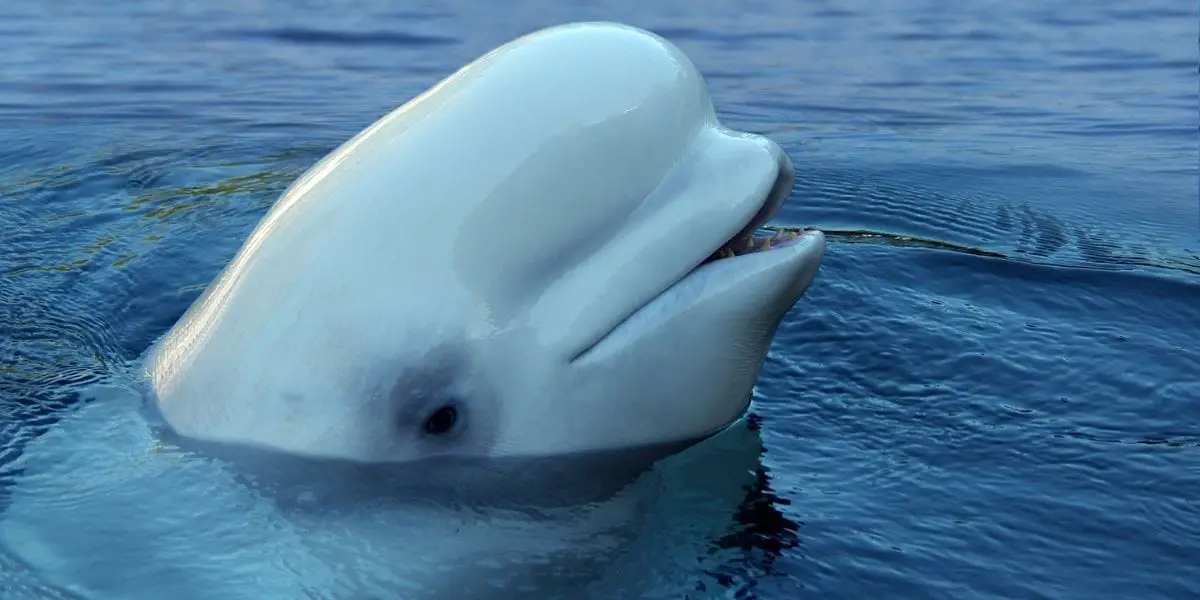Beluga whales are small marine mammals that inhabit the Arctic Ocean and its nearby seas. These “melon-headed” whales are famous for their big squishy heads and being very vocal. They do not look like any ordinary whale, but why?
Beluga whales have big heads that contain their melon, an organ that generates high and low-frequency sounds for communicating, feeding, and traveling. The melon of a beluga whale appears larger than other whales because it overhangs its rostrum (beak) and is squishy because it contains fatty tissue, wax, and oil.
Keep reading to find out more about the features of a beluga whale head, and how being melon-headed helps echolocation.
Why Do Beluga Whales Have Big Heads?
The structure of the beluga whale’s head makes it appear particularly large. Beluga whales are “melon-headed” whales. Other toothed whales have melons, but Beluga whales are a little different.
The head of a beluga whale looks bigger than others because their melon overhangs over their beak. Their beak (also known as their rostrum) is notably short but distinct1 (source: Seaworld).
Their melon is an organ at the forefront of the Beluga whale’s head. Their melon is not their brain. Their brain is encased in a skull and is located further inside the body2 (source: Wikipedia). All toothed whales have melons, but not all are squishy.
What Do Beluga Whales Use Their ‘Melon’ For?
Beluga whales use their melon when communicating, feeding, and traveling. The melon can change the frequency of noises that whales generate. This is particularly important for echolocation purposes3 (source: H. Delphine, Marine Mammals of Eastern North Pacific and Arctic Waters 2 ed, 1986).
Echolocation is used by whales (and other mammals) to find and identify objects. This is done by creating sounds and monitoring the echoes created. Beluga whales are famous for creating a variety of noises.
Beluga whales, and other toothed whales, use echoes from high-frequency sound pulses to navigate and locate prey, and use low-frequency sound to communicate with other individuals over long distances4 (source: National Research Council (US) Committee on Low-Frequency Sound and Marine Mammals, 1994).
Why Do Beluga Whales Have Squishy Heads?
Beluga whale heads appear to be squishy because of what their melon contains. Their melon contains fatty tissue (also known as lipids), wax, and oil5 (source: H. Delphine, Marine Mammals of Eastern North Pacific and Arctic Waters 2 ed, 1986). This makes their melon flexible and squishy.
The beluga whale is known for having a particularly malleable and squishy melon6 (source: B.G. Würsig, et al., Encyclopedia of Marine Mammals, 2017). Their squishy melon is located above the rostrum (beak) and in front of the blowhole7 (source: H. Delphine, Marine Mammals of Eastern North Pacific and Arctic Waters 2 ed, 1986).
Can Beluga Whales Change the Shape of Their Head?
Beluga whales can change the shape of their melon. Their melon is at the front of their head. Not all whales can change the shape of their melon. The melon of a beluga whale is more flexible than other species8 (source: Seaworld).
Belugas change the shape of their melon to assist echolocation. Changing the shape allows them to focus and direct noises through the water9 (source: H. Delphine, Marine Mammals of Eastern North Pacific and Arctic Waters 2 ed, 1986). Beluga whales change the shape of their melon by blowing air around its sinuses.
Changing the shape of their melon is what makes Beluga whales masters of this bio-sonar system10 (source: C.W. Turl, et al, Canadian Bulletin of Fisheries and Aquatic Sciences, Vol 224: 119–128, 1990). Their melon is known to change shape during vocalizations.
Is It Bad to Squish a Beluga Whales Head?
Squishing the head of a Beluga whale is not directly touching the brain. The brain is well protected in a hard skull further inside the body11 (source: Wikipedia). Despite this, you still should not touch/squish the head of a beluga whale.
You may have seen Beluga whales in viral photos and videos displaying their bulbous/squishy head shape. There are even videos of people prodding/squishing the head of beluga whales.
Please reconsider your actions before going to squish a whale’s head.
Related Questions
Do Beluga Whales Have Teeth?
Yes, Beluga whales have teeth. Belugas are toothed whales. They have an average of 34 teeth. Beluga whales use their teeth for tearing and grasping12 (source: Seaworld).
Their teeth are not designed for chewing. Belugas whales develop permanent teeth at around the age of two and keep these for their entire life13 (source: https://baleinesendirect.org/en/les-baleines-ont-elles-des-dents-de-bebe/). Other whales do not have teeth: most of these are baleen whales.



![Read more about the article Do Beluga Whales Have Knees? [No – Here’s What They Really Are]](https://polarguidebook.com/wp-content/uploads/2022/01/Do-Beluga-Whales-Have-Knees-300x176.jpg)

![Read more about the article Are Beluga Whales Intelligent? [Here’s What Scientists Say]](https://polarguidebook.com/wp-content/uploads/2022/04/Are-beluga-whales-intelligent-300x150.jpg)